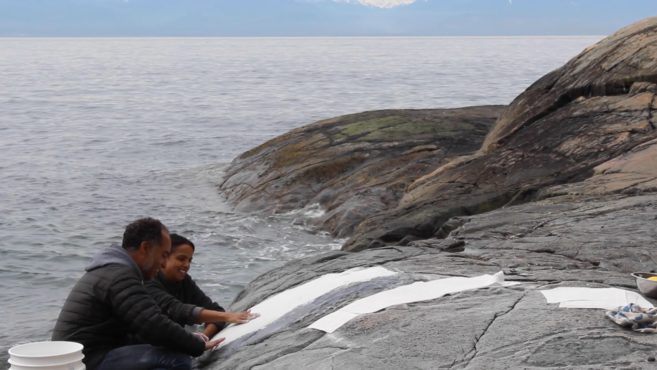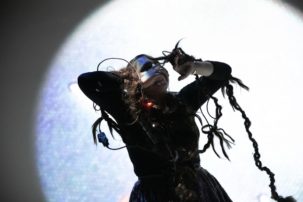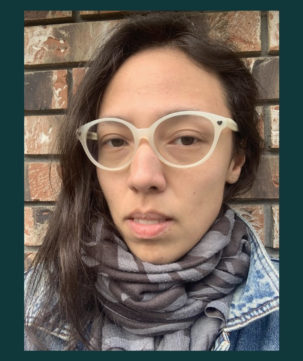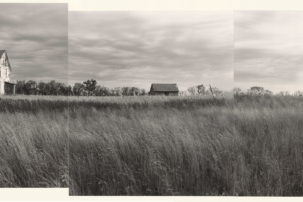I met Katherine Boyer when we were teenagers, singing together in choir at a public high school in Regina, two working-class kids co-existing among the ranks of the city’s upper middle-class teens. This was in Treaty 4 lands in Saskatchewan, where you could feel how class dynamics structured the city and its geographies even in the context of the public school system—and you could see how these dynamics were racialized, even racist, most perniciously for the many Indigenous people living there. It wasn’t until we were both undergraduate students in fine arts at the University of Regina that I learned that Katherine was Métis—a word I hadn’t known previously.
A few years later, I took in Boyer’s intricate, beaded panels at the Dunlop Art Gallery as part of the group exhibition “Material Girls,” and began to understand what it might mean to make contemporary art as a Métis artist, particularly one committed to researching and reflecting upon Métis visual culture, as Boyer is. On the occasion of her upcoming exhibition and her first solo show in Toronto, “The Prairie Rose Won’t Mourn Us,” which opens at Zalucky Contemporary this weekend, we spoke about her beading practice, the relationship between beading and generational knowledge and her newest body of work.
Lauren Fournier: When we were talking about daily rituals, you told me that you bead every morning, right after you wake up and make your coffee.
Katherine Boyer: I try my very best to bead every morning: it has to be extreme circumstances, like travelling, for me to not start my day with this ritual. I bead every single morning. My mental acuteness is at its highest from 5 a.m. to 8 a.m., so I use that sharp moment of my day for beading. While some people might start their day with meditation—which I can’t do!—beading has become the time for me to sit, to drink coffee, to have three hours before I have to head out the door. It’s a time for me to warm up my hands to that creative type of energy.
LF: When did you learn how to bead? Who taught you, or were you self-taught?
KB: I learned how to bead when I was working at the First Nations University of Canada. My job was to take care of the art gallery and the art collection. Very fortunately for me, I was working hand-in-hand with the fine arts department and the incredible artist Judy Anderson let me sit in on one of her beading courses. I started off with the same project that everyone had been assigned and I remember this one moment so clearly. I was at home, and I had brought my beads home from work. I was sitting there and my hands were so clumsy and I was frustrated, but at the same time filled with this very, very deep craving to make it work. Beading felt right in so many ways. I remember thinking, after that first project, “I’m going to do a second piece: I’m ready for it—I’m ready to build on what I’ve learned.”
During longer artist talks, I always like to show this first work. To me it’s important to acknowledge and recognize where those skills came from, and who taught you. Even though we don’t work together anymore, Judy is still a big part of my life. I consider her my mentor, a very close friend and confidante.
LF: Did this piece have a title? Did you see it as an “artwork”?
KB: You’re going to laugh. First, I’ll tell you what the class project entailed: Judy taught us three stitches, so we had to use those stitches in this piece and do a series of geometric shapes. I ended up doing an entirely white piece with white beads, making different shapes—circles, triangles. I titled it “If Malevich were Métis.”
LF: Aw! Yeah, it’s so interesting to see how an artist’s practice evolves, especially as an artist continues to work in a given medium for an extended period of time, refining their work in relation to the themes that were there from the beginning, which in your case might mean exploring Métis identity and visual culture. Thinking about the First Nations University in Treaty 4, and the context of Treaty 4 lands more broadly, makes me think of the ways in which your beadwork is often tied to land that you have a historical and ancestral relationship with. You often work two-dimensionally, with much of your earlier beadwork focusing on geographies, mapping and the politics of place, and the place-responsive work that emerged from your immersion in local archives as a Métis person raised in Regina and now living and working in Winnipeg, in Treaty 1. Can you speak about this shift in your practice?
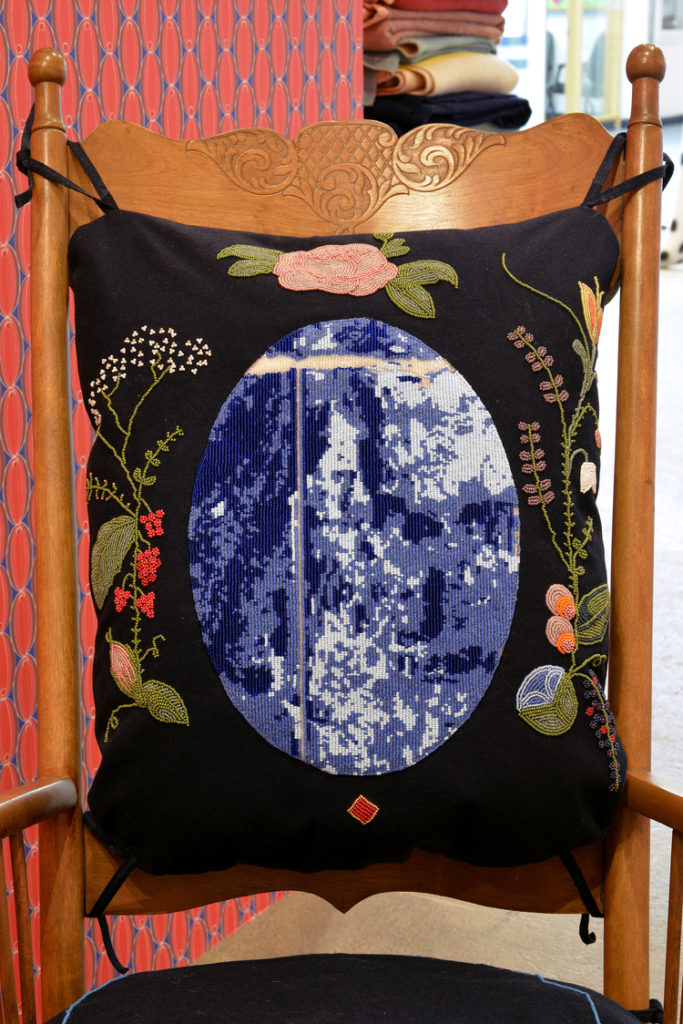
Katherine Boyer, Maman, Nous Détournons (detail), 2015. Seed beads, stroud cloth, rocking chair. Dimensions variable. Installation view in "Material Girls." Courtesy the Dunlop Art Gallery.

Katherine Boyer, Red River Trails, 2014. Seed beads, stroud cloth, 16 x 20 in. Courtesy the artist.
KB: This period, of developing mapping projects and visually working with the land on a more macro level, was the first time that I began exploring my cultural heritage in my art practice. Prior to that, my work had been focused on grieving my late mother. During that time, I was trying to find where my place was, and how I fit into a bigger cultural and social context. Working with this zoomed-out view of land, I now see it so clearly as a good place to start—to see land without borders, which we didn’t get taught in school. I know that my high-school experience, maybe yours too, did not include much about Métis history and did not discuss how invasive borders are to a Métis person’s way of living.
So, that wide-looking, Google Map–view approach to land-based thinking was part of my efforts to find my place. What this gradually led to was a narrowing in, to a closer perspective on land. Once I started to see myself, and how my family moved from one side of the Medicine Line to the next up into Canada, I could start to zoom in: what did that land mean to them, to actually walk it? I began to bring in a more experiential reflection, looking at plants, looking at networks of nature, at cycles. I see those areas as being closely related. This piece I did called Contours of Plains is a perfect example of those two worlds and how I see them working together: it’s a different perspective on the same thing, I think.
LF: Can you tell me about your upcoming exhibition “The Prairie Rose Won’t Mourn Us?”
KB: The idea for the exhibition came after reading the story “The Year the Roses Died” by Mary Siisip Geniusz in the book Plants Have So Much to Give Us, All We Have to Do Is Ask: Anishinaabe Botanical Teachings (2015). It’s a complex story that covers a lot of different things for different people, but one thing that really struck me was the description of life cycles and different species’ degrees of reliance on others for survival. Plants can sustain themselves from their environment; animals require plants to live, but are also partially self-sustaining. It is only humans who are entirely reliant on others—plants and animals—for survival. This really shifts the hierarchy of power from humans on the top to humans being the most vulnerable, in the grand scheme of things, because we are so reliant on our world, our animal neighbours and plants to support our lives.
The title of the exhibition draws on two things: in the story, all of the roses were eaten by the animals. The roses eventually return, but with thorns for self-protection—now they are prepared. The rose exists as a cautionary tale against over-consumption. The roses won’t miss us when we’re gone from this planet, when we’ve destroyed ourselves, but I do believe that plants have an innate ability to survive and they certainly don’t need us. The prairie rose is an important flower and symbol for Métis women, in particular. The prairie rose is durable, tenacious, beautiful and widely found on the Plains. It appears in a lot of old Métis beadwork, so it’s clear to me that we, as Métis artists, have long looked to this plant for inspiration and answers.
LF: Has the process of beading plants changed your perspective on your beading practice in general?
KB: To produce this floral beadwork, I studied previous examples of beaded flowers, trying to understand the forms and creative choices by studying them. And what I’ve come to now is that I do more of my own translations—which isn’t exactly the right word—but I’ll look at a plant in real life and think about its biology, its plant “nature,” and then do my own depiction of it. This was an important turning point for me, in representing flowers. I used to lament the fact that my family, as far as I know, still does not have any beadwork designs that have been passed down. I had always thought of this as a raw deal—like, “colonization, this is so unjust”—and I was more angry about it than anything. Until one day I was speaking with a Métis Elder and when I relayed this he told me that, rather than feeling like something has been lost, go out and start from scratch, rebuild a floral vocabulary that you can pass down. And that, it may be hard to do that work but the other side of it means your children will have designs that they can call their own. This will become a way of ultimately restoring the line of information passed down through generations.
LF: Beading has been a way for you to work through issues related to the labour involved in Indigenous beading practices—labour that is gendered and historically un- or under-acknowledged. It’s one thing to think about this labour, and quite another to start each day by doing the labour of beading as an artist.
KB: When I was growing up, my mom taught me how to sew and my grandmother taught me how to knit: of course, these two ways of creating are considered very gendered. Another thing I saw as a young girl was the care that exuded from those female relatives: their labour was domestic and not necessarily the visual work of art making. I still think that is the core of why I take the time, and why I spend such an absurd amount of time, doing this work—it’s to connect with that place, and that memory, of all of those women (from my family) that is founded in care and connection, in physical work. I form a very strong bond with my materials, because I spend hundreds of hours touching them. I take them very much as an animated material, they all have a place where they are going to fit: they each have a neighbour, and an order, and I’m just there to place them. I think that what it comes down to, when it comes to my motivation to bead, is to create a bond between all of those forces. I see a strong tie between using these materials and connecting to the familial memory that I’ve just described—it’s an important place of grounding. But it’s not all magic.
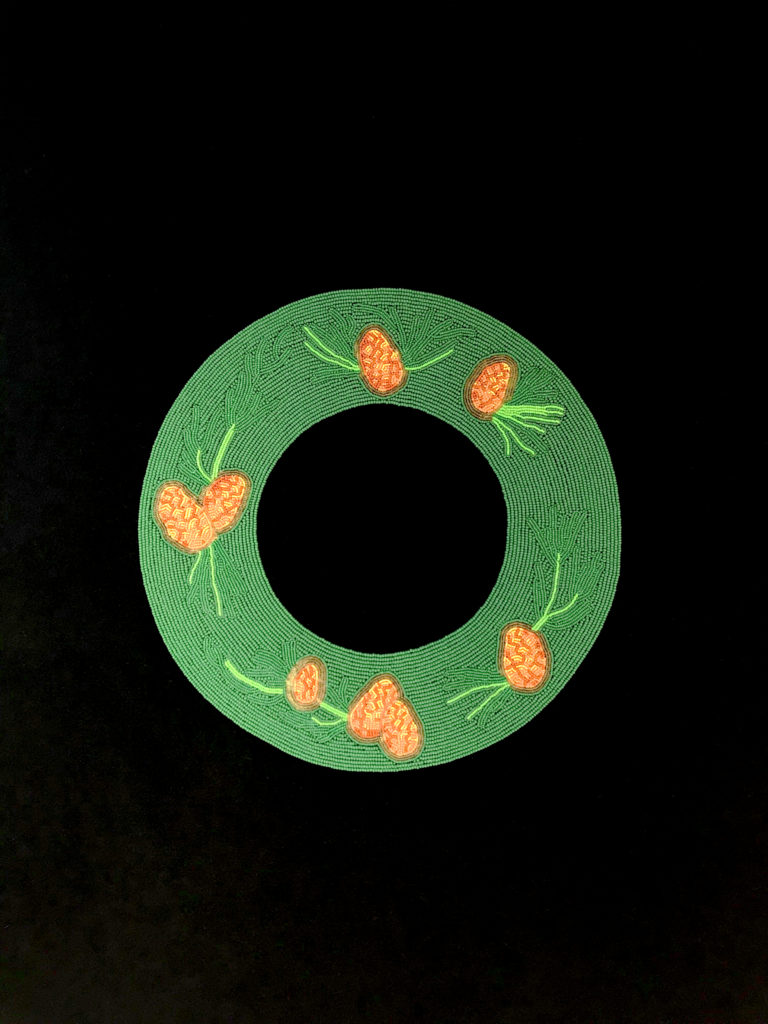 Katherine Boyer, Responsibility of Fire (detail), 2018, 20 x 25 in. Courtesy the artist.
Katherine Boyer, Responsibility of Fire (detail), 2018, 20 x 25 in. Courtesy the artist.
LF: In your work Four Generations a Broken Back, you inscribe the spinal cord within the body of the moon as a way of representing the physical toll that beadwork takes on your body. How do you feel when you’re beading? And how do you feel after you bead?
KB: Typically after I bead, I have a backache and my eyes are blurry. I’ve got a lot of back and eye issues from beading. I do try to mitigate that, taking breaks every 20 minutes and looking up and all that. But the physical repercussions of my art practice can be seen as a parallel to the broken backs of women throughout history—of the toll that invisible labour takes on their bodies.
LF: Given the enormous amount of time that goes into beading, and the intricacies of beadwork, I imagine you must do a lot of this work alone. What has the relationship been, historically, between Métis beading practice and the larger community? Are you part of a beading community in Manitoba?
KB: These beading practices were a way for people to get back together, to catch up, to share news, and even to network. Where we are currently, socially, this is harder to do. I, like many, go to work and then I’m tired at the end of the day. One of the reasons I do my beading in the morning is because of this. I’ve done some beading groups here in Winnipeg, but as much as I’d like to return there each week, it’s not something that really fits into my schedule—not a lot of people want to get together at 5 a.m. to bead! But when I do get the opportunity to work with fellow beaders, like Judy Anderson and Catherine Blackburn, it’s a reminder that our community is still intact—it might just be farther apart. Social media helps to bridge those wider gaps, so where previously you’d go down the road to meet up with your neighbours, in a way we’re meeting up online. I support others, and others support me, through words of enthusiasm and encouragement on Instagram, for example. That is a place where I find invaluable inspiration and camaraderie.
LF: You were one of the artists featured in “Li Salay” (Michif for “the sun”), an exhibition curated by Jessie-Ray Short and Amy Malbeuf at the Art Gallery of Alberta that brought together Métis artists. It foregrounded the connections and contemporary resonances of Métis art practices today, especially of Métis feminisms. How did this experience shape your understanding of where your own practice fits in?
KB: One of the things I’ve come to consider as my responsibility as an artist is the need to tell my own story: which is my family’s story and our journey. What I didn’t realize I was lacking before “Li Salay” was the excitement and the sheer joy of being identified, specifically, in that way, being among other Métis artists. And I’m getting a bit emotional, because it was so significant to be recognized by those who are my direct relations—you don’t consciously think of how broad the category Indigenous is. It has been important for a lot of different reasons, but to be able to land yourself and find yourself specifically among the other people who share such exact similar circumstances and family stories and ways of looking at the world is just very, very important. I would further emphasize how affirming this Métis-centred exhibition was. I am not saying that exhibitions that open up to all Indigenous experiences are in any way less important. There was just something really empowering about the specificity of uniting under one identity. And, it was really fun.
“The Prairie Rose Won’t Mourn Us” opens at Zalucky Contemporary on Saturday, November 24, 2018.

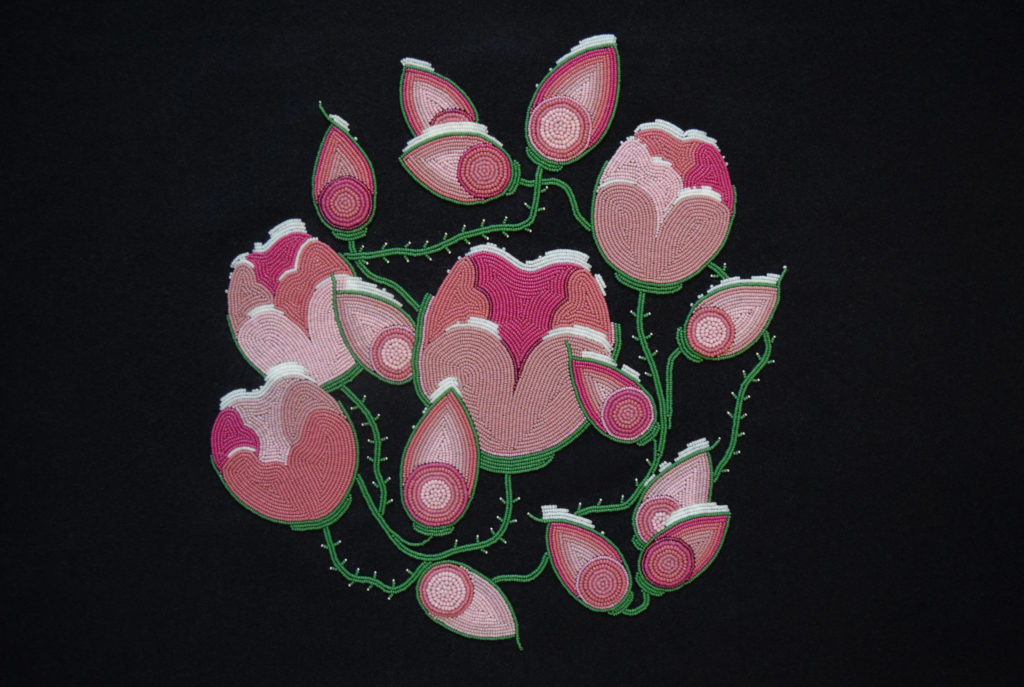 Katherine Boyer, The Cycle Shifts Clockwise, 2018. Seed beads, stroud cloth, 22 x 28 in. Courtesy the artist.
Katherine Boyer, The Cycle Shifts Clockwise, 2018. Seed beads, stroud cloth, 22 x 28 in. Courtesy the artist.
